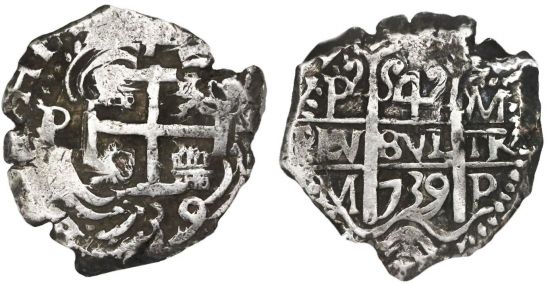Difference between revisions of "Bolivia 1739-P M 4 reales"
m (Text replacement - "Potosi," to "Potosí,") |
m (Text replacement - "Potosi mint" to "Potosí mint") |
||
| Line 1: | Line 1: | ||
[[Image:Bolivia Sed26-530.jpg|550px|thumb|Sedwick Treasure auction 26, lot 530]] | [[Image:Bolivia Sed26-530.jpg|550px|thumb|Sedwick Treasure auction 26, lot 530]] | ||
| − | This specimen was lot 530 in Sedwick Treasure Auction 26 (Winter Park, FL, November 2019), where it sold for $464.10. The catalog description<sup>[1]</sup> noted, "Potosí, [[Bolivia]], cob 4 reales, 1739M, NGC VF 35. Choice full pillars and cross with two dates and assayers, three mintmarks, deep toning and encrustation in crevices, typically crude edge, overall more like XF in our estimation." The Spanish colony of Upper Peru produced hammered cob coinage at the | + | This specimen was lot 530 in Sedwick Treasure Auction 26 (Winter Park, FL, November 2019), where it sold for $464.10. The catalog description<sup>[1]</sup> noted, "Potosí, [[Bolivia]], cob 4 reales, 1739M, NGC VF 35. Choice full pillars and cross with two dates and assayers, three mintmarks, deep toning and encrustation in crevices, typically crude edge, overall more like XF in our estimation." The Spanish colony of Upper Peru produced hammered cob coinage at the Potosí mint from 1573 to 1773, with a major debasement scandal and subsequent reform occurring in 1649-1652. The period 1767-1770 saw the simultaneous issue of milled columnarios. The royal or presentation issues are very rare and highly sought after, while the regular strikes vary in price according to the visibility of the date, mint, and assayer initials. |
''Recorded mintage:'' unknown. | ''Recorded mintage:'' unknown. | ||
Revision as of 10:28, 23 May 2025
This specimen was lot 530 in Sedwick Treasure Auction 26 (Winter Park, FL, November 2019), where it sold for $464.10. The catalog description[1] noted, "Potosí, Bolivia, cob 4 reales, 1739M, NGC VF 35. Choice full pillars and cross with two dates and assayers, three mintmarks, deep toning and encrustation in crevices, typically crude edge, overall more like XF in our estimation." The Spanish colony of Upper Peru produced hammered cob coinage at the Potosí mint from 1573 to 1773, with a major debasement scandal and subsequent reform occurring in 1649-1652. The period 1767-1770 saw the simultaneous issue of milled columnarios. The royal or presentation issues are very rare and highly sought after, while the regular strikes vary in price according to the visibility of the date, mint, and assayer initials.
Recorded mintage: unknown.
Specification: 13.54 g, 0.931 fine silver.
Catalog reference: S-P47; KM-30a; CT-1122, Cayón-9120.
- Michael, Thomas, Standard Catalog of World Coins, 1701-1800, 7th ed., Iola, WI: Krause Publications, 2016.
- Cayón, Adolfo, Clemente Cayón and Juan Cayón, Las Monedas Españolas, del Tremis al Euro: del 411 a Nuestros Dias, vol. 1, Madrid: Cayón-Jano S.L., 2005.
- Calicó, Xavier, Numismática Española: Catálogo General con Precios de Todas las Monedas Españolas Acuñadas desde Los Reyes Católicos Hasta Juan Carlos I, 1474 a 2001, Barcelona: Aureo & Calicó, 2008.
- Menzel, Sewall, Cobs, Pieces of Eight and Treasure Coins, New York: The American Numismatic Society, 2004.
- [1]Sedwick, Daniel Frank, Augi Garcia and Cori Sedwick Downing, Treasure Auction 26, Winter Park, FL: Daniel Frank Sedwick LLC, 2019.
Link to:
